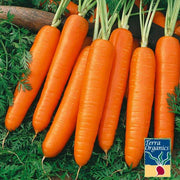Growing Organic Scarlet Nantes Carrot Vegetable Seeds
How to Grow Organic Scarlet Nantes Carrot from Seed
Organic Scarlet Nantes carrot is a cool weather crop best sown directly 2-3 weeks before final spring frost and every 2 weeks after for successive harvests. Like many root vegetables, carrot does not transplant well and should be sown directly. Plant 2-3 seeds 1/2" deep and 1-2" apart in loamy, loose, and well-drained soil with a pH of 6.0-7.0. Seeds germinate in 14-21 days, thinning back to 1 plant every 2-4" as true leaves establish. Carrots require a deep well-tilled garden for straight taproot growth. Avoid using nitrogen-rich fertilizers which are known to cause root abnormalities as well as excessive greens and weak root development.
These Organic carrots should be planted in soil with a pH level of approximately five to seven. The soil should also be sandy and moist, with few rocks or lumps to get in the way of the root growth. Sow the seeds in the spring in an area with full sun by placing half an inch of soil over each seed.
Keep two to three inches between each plant and 12-14" between each row. Water them each week to keep the soil consistently moist, and watch out for pests such as the carrot rust fly. After around seventy five days, or when they appear to have reached full size, the Scarlet Nantes carrots will be ready to be harvested.
Organic Scarlet Nantes Carrots in the Vegetable Garden
Each carrot grows around seven inches long, and is sweet and tender with a satisfying crunch. Recommended by Utah State University, Scarlet Nantes carrots are sweet, plump, and coreless. The Scarlet Nantes carrot grows very cylindrical roots, with rounded ends, that are excellent for bunching. This crop does well in zones three to nine, in an area with full sun. It needs sandy and well-drained soil with little to no rocks. After around 70 days, these carrots are ready to be pulled out of the ground and enjoyed in an array of dishes.
Carrot is a sugary sweet root vegetable second only to the beet in overall sugar content. Carrot is one of the easiest, quickest, and most satisfying garden crops and lends itself to as many savory dishes as it does sweet. Although considered a predominantly orange vegetable, the carrot is available in a wide selection of exquisite heirloom colors such as red, purple, yellow, and white. Carrots can be sown every couple weeks for successive season-long harvesting.
Harvesting Organic Scarlet Nantes Carrots
Most varieties of carrot are ready for harvest about 70-80 days from sowing, while smaller varieties such as Parisian are ready a few weeks sooner. Regardless of color, carrots are usually ripe for harvest when the root begins to show above soil.
A sandy and well-tilled garden will help in harvesting, providing a loose soil to safely uproot the carrot crop without the need for tools. For more hardened soils, use a specialized hand cultivator or garden hori-hori knife.
About Organic Scarlet Nantes Carrot Garden Seeds
Recommended by Utah State University, Scarlet Nantes carrots are sweet, plump, and coreless.
Prior to the Dutch influence of the 16th century, the world's carrot crop had once been entirely purple, whereas orange was the mutant variable that Dutch growers sought to isolate as a separate cultivar. Orange has since become the commercial standard while many purple heirlooms are resigned to home gardens, specialty stores, and farmers" markets.
1927 Henry Fields Seed Company Catalog says about Scarlet Nantes Carrot Seeds...
"The roots are bright orange, 5 to 6 inches long and very uniform. They have very small core and are exceptionally tender and sweet. The roots are rather slender, of even diameter and of early maturity. Very desirable for market, especially for bunching, and also splendid for the home garden."
1937 MacFayden Seed Company says about "nantes."..
"Early, Delicate Flavor, Coreless. A splendid home and market garden variety. Tops are small, and the rows can be planted close. Roots 6 to 8 ins. long, bright orange, cylindrical, blunt ended. Flesh reddish orange, crisp, tender and of very delicate flavor. Early maturing and practically coreless."






